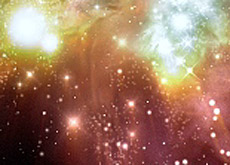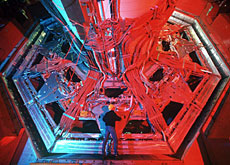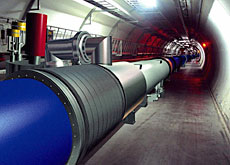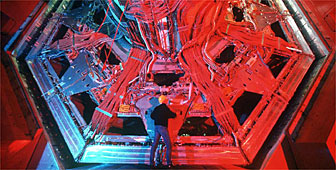Understanding the universe is no small matter

For half a century, particle physicists at Cern, the European Organization for Nuclear Research, have been searching for what constitutes matter.
Their work has already been rewarded with three Nobel prizes, but they are still hunting for infinitely smaller prizes with their huge detectors near Geneva.
“Cern helps understand the universe,” said James Gillies, spokesman for the world’s biggest particle physics laboratory. “What it’s made of, where it comes from, and where it’s going.”
When Cern was created 50 years ago, understanding of matter did not extend beyond the atomic nucleus. Theoretical physics had already stated there were smaller particles than protons and neutrons, but nobody had been able to detect them.
Particle physicists consider objects so small that even the most powerful microscopes cannot see them. The size of an atom nucleus is typically one thousandth of one billionth of a metre, and Cern is striving to probe deeper than that.
Tracks
Particles display wavelike behaviour, and like waves, they leave a trace behind, not unlike a high-flying jet.
Scientists at Cern make use of this property, by sending particles – electrons, neutrons or protons – down long vacuum tubes surrounded by electromagnetic fields, which are called particle accelerators.
Once the particle comes close to the speed of light, it is smashed into other particles or a target. The researchers study the tracks left by the crash to try to understand the underlying structure of matter.
But technology developed at the Geneva laboratory for particle accelerators has done more than just study the structure of matter.
In 1968 Georges Charpak designed a detector that eventually led to new forms of medical imaging. Charpak received the 1992 Nobel Physics prize for his work.
Accelerators can also help create particles. Thanks to Einstein’s equation where energy equals mass times the speed of light squared, scientists know that matter can be converted into energy and vice versa.
The energy from some collisions is enough to create matter, or in some cases, anti-matter, as experiments at Cern have shown.
Unified theory
Over the years, researchers at the laboratory have had one major goal: to come up with a single theory to unify the four forces that describe all known interactions between objects.
These forces – gravity, electromagnetic, strong and weak – are all well understood in their own right. But scientists would rather have one theory rather than four individual ones.
The unified field theory, as Einstein called it, is often considered the holy grail of physics.
This is not so surprising since it has proven just as elusive. Einstein himself came up short.
Two forces – electromagnetic and weak – were “unified” into a single theory in the 1970s. This theory was verified later in a Nobel prize-winning experiment at Cern.
The weakest and the strongest forces, however, gravity and the strong force, remain poles apart.
Higgs boson
So far, the best theory on what constitutes the fundamental building blocks of matter and how they interact is called the “Standard Model”. But this theory has a major stumbling block.
“The model is fine so long as you consider particles have no mass,” Gillies told swissinfo. “We now know that they do, but we don’t know why.”
The answer may lie with the mysterious Higgs boson, an elusive particle whose existence was first advanced by a British physicist.
In an attempt to find the Higgs boson, Cern is investing SFr3.2 billion ($2.57 billion) on a new accelerator, the Large Hadron Collider (LHC).
Due to come online in 2007, it will take over from the 27-kilometre-long Large Electron Positron Collider (LEP), which has been running for 16 years.
The LHC will be the same size, but 70 times more powerful than the LEP, producing bigger collisions.
Dark matter
Cern’s researchers won’t be just chasing the Higgs boson, though. They will also continue to probe the secrets of anti-matter, and try to shed light on so-called “dark matter”.
Scientists believe that the visible universe only contains at most five per cent of all matter. It is thought that huge quantities of invisible matter may explain why the universe is continually expanding.
“Black holes”, collapsed stars whose gravity is so strong that not even light can escape from it, are believed to be made up of dark matter.
But these holes cannot account for all invisible matter. Physicists reckon there must be unknown heavy particles scattered throughout the universe that have been around since the beginning of time.
“We hope to have enough energy with the LHC to create some of these particles,” said Gillies. “If we do, we can expect to make many more discoveries.”
swissinfo
Cern was founded in 1954 by nine states, including Switzerland.
It straddles the border with France near Geneva.
Nearly 3,000 people work on the site, but 6,500 reseachers have access to Cern, or around half the planet’s particle physicists.
Its centrepiece until now has been the LEP collider, but a new accelerator, the LHC, is being built.
The first Nobel prizes awarded to Cern researchers went to Carlo Rubbia and Simon Van der Meer in 1984 for the discovery of the W and Z bosons.
Their research confirmed the unification theory of the weak and electromagnetic forces.
Cern is also known as the birthplace of the World Wide Web at the beginning of the 1990s.

In compliance with the JTI standards
More: SWI swissinfo.ch certified by the Journalism Trust Initiative




You can find an overview of ongoing debates with our journalists here. Please join us!
If you want to start a conversation about a topic raised in this article or want to report factual errors, email us at english@swissinfo.ch.